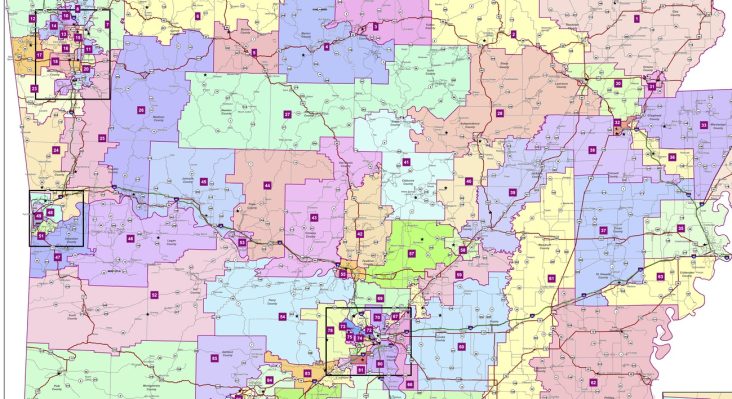New legislative maps would include district with majority voting age Latinos
by November 29, 2021 2:12 pm 1,639 views

Arkansas would have 12 majority-minority state House districts including its first with a majority voting-age Latino population under maps approved by the Board of Apportionment Monday (Nov. 29).
Four Senate districts would be composed of a majority of African-American residents, the same as are currently.
The new House and Senate maps reflect changes from draft maps released Oct. 29 in which 13 House districts would have been majority-minority. The month-long comment period, which produced more than 800 comments, revealed that the majority Latino district would not have been composed of a majority of voting age residents.
The Board approved the changes to the maps unanimously during a 24-minute meeting. The maps can be viewed at this link. They are set to take effect Dec. 30 unless challenged in court, which Gov. Asa Hutchinson expects will happen and which the chairman of the Democratic Party of Arkansas predicted will happen.
The Board of Apportionment is composed of Hutchinson, Attorney General Leslie Rutledge, and Secretary of State John Thurston. The persons holding those offices meet every 10 years following the U.S. Census to redraw state legislative lines to reflect population changes.
Former Supreme Court Justice Betty Dickey told the board that the number of majority-minority House districts increased from 11 drawn in 2011 to 12 under the new maps. Hutchinson said the majorities would be composed of voting age residents.
Hutchinson said numerous changes were made as a result of the comment period, which Dickey said was the first performed by a Board of Apportionment. Those included House District 9 in the Springdale area, which was redrawn to ensure a majority of its residents would be Latinos of voting age.
However, the change did not bring the area’s current House member, Rep. Megan Godfrey, D-Springdale, back into the district. She was drawn out of it under the draft map and remains so now. Dickey said many comments indicated support for drawing Godfrey into the district while some comments supported the district Iines as drawn.
Hutchinson said in an interview that the priority was to get the district above 50% voting age Latino population.
“There was not an agreement to change it,” he said. “So in other words, there weren’t enough votes to move that around enough.”
Asked if there was a way to draw her in, Hutchinson said, “There might have been a way, but that didn’t get the votes … on the Board.”
Asked if he wanted Godfrey to be drawn into the district, he said, “We presented ways that that could have been done, but again, the priority was getting that Latino district up to a voting age majority.”
The governor said that, overall, the maps were improved over the drafts.
Democratic Party of Arkansas Chairman Grant Tennille said in a statement that the currently drawn Springdale district has already become majority Latino. He said the maps would dilute minority voters in the Delta and would weaken minority incumbents along the Mississippi River and south Arkansas.
“These newly drawn maps are illegal,” Tennille said. “The people who drew them know it, and they know they’ll be headed to court.”
Hutchinson said he expects the maps to be reviewed by the courts. Rutledge said the maps are fair and that they do not violate federal law, including the 14th Amendment and the 1964 Voting Rights Act, as well as Arkansas’ Constitution.
Elsewhere in the House, lines for District 4 and 5 were redrawn so that Mountain Home would be entirely in one district rather than split. The northern part of Jonesboro was drawn into the rest of the city. Fort Smith’s northside communities of interest were drawn together. In Bradley County, precincts surrounding Hermitage were added to the district to make it more compact, Hutchinson said.
In the Senate, Fort Smith was kept whole, Hot Springs Village was drawn into one district, and splits in Searcy and Stone counties were removed.
House Minority Leader Tippi McCullough, D-Little Rock, who was at the Board meeting, said, “I know they made a lot of changes, but there weren’t a lot of changes that affected our incumbents in a positive way.”
Dickey told the Board that the number of whole counties represented in House districts increased from 13 to 24, while the number of whole counties in Senate districts increased from 37 to 40. Population deviations from the largest to the smallest districts decreased from 8.38% to 6.85% in the House, and from 8.2% to 5.49% in the Senate.
Continuity of representation was one of the goals. No Senate districts would pit incumbents against each other. There would be one House district that would be home to three current incumbents, the new House District 62 in eastern Arkansas. The area is currently represented by Rep. Reginald Murdock, D-Marianna; Rep. David Tollett, R-Lexa; and Rep. Mark McElroy, R-Tillar.
Dickey said staff tried to minimize partisanship and didn’t load political data into the system.
Dickey’s contract is set to expire after Dec. 15. The Board agreed to allow it to do so and then to work out arrangements if she is needed afterwards.
Thurston said the individual districts will be listed online Wednesday or Thursday at https://arkansasredistricting.org.
